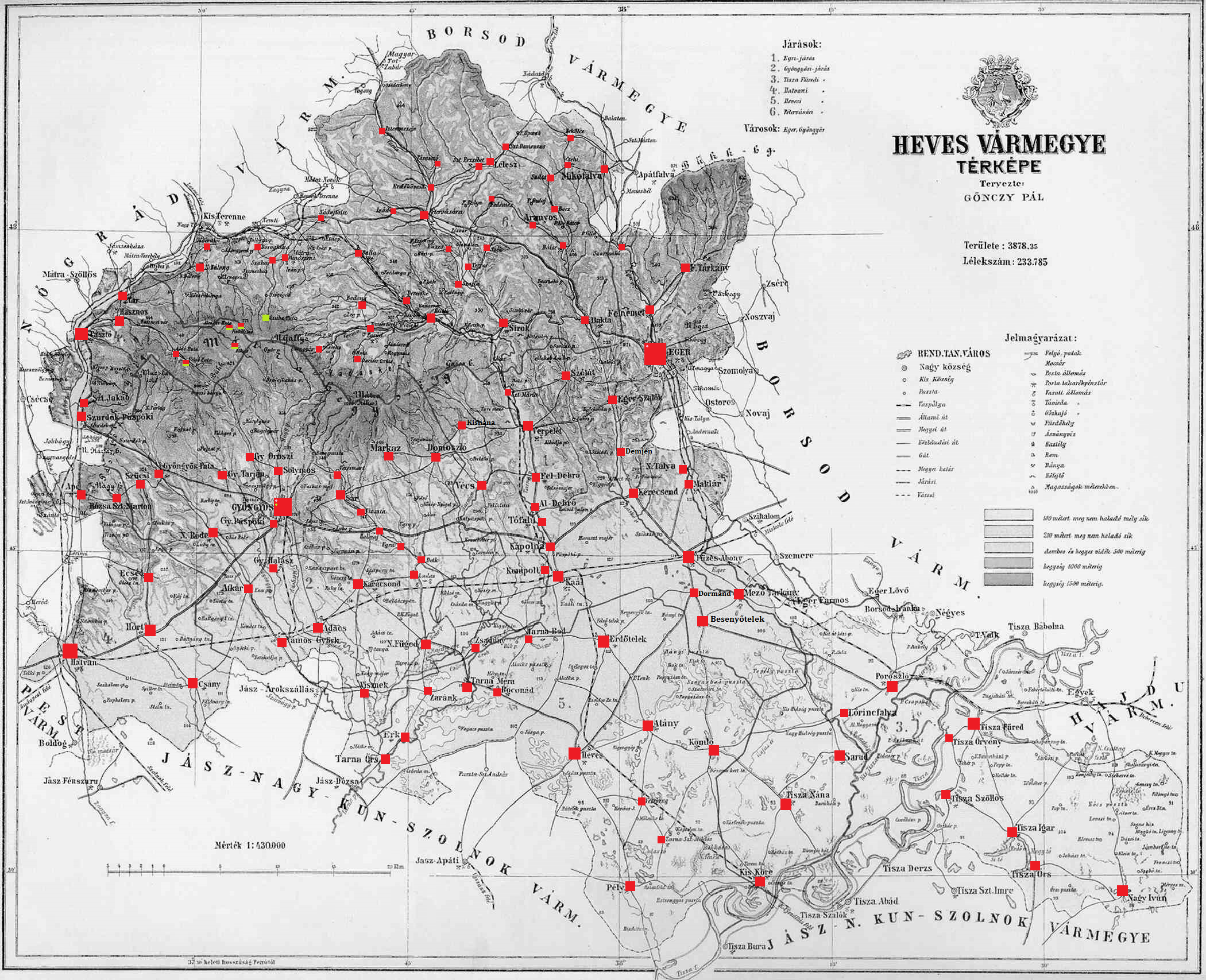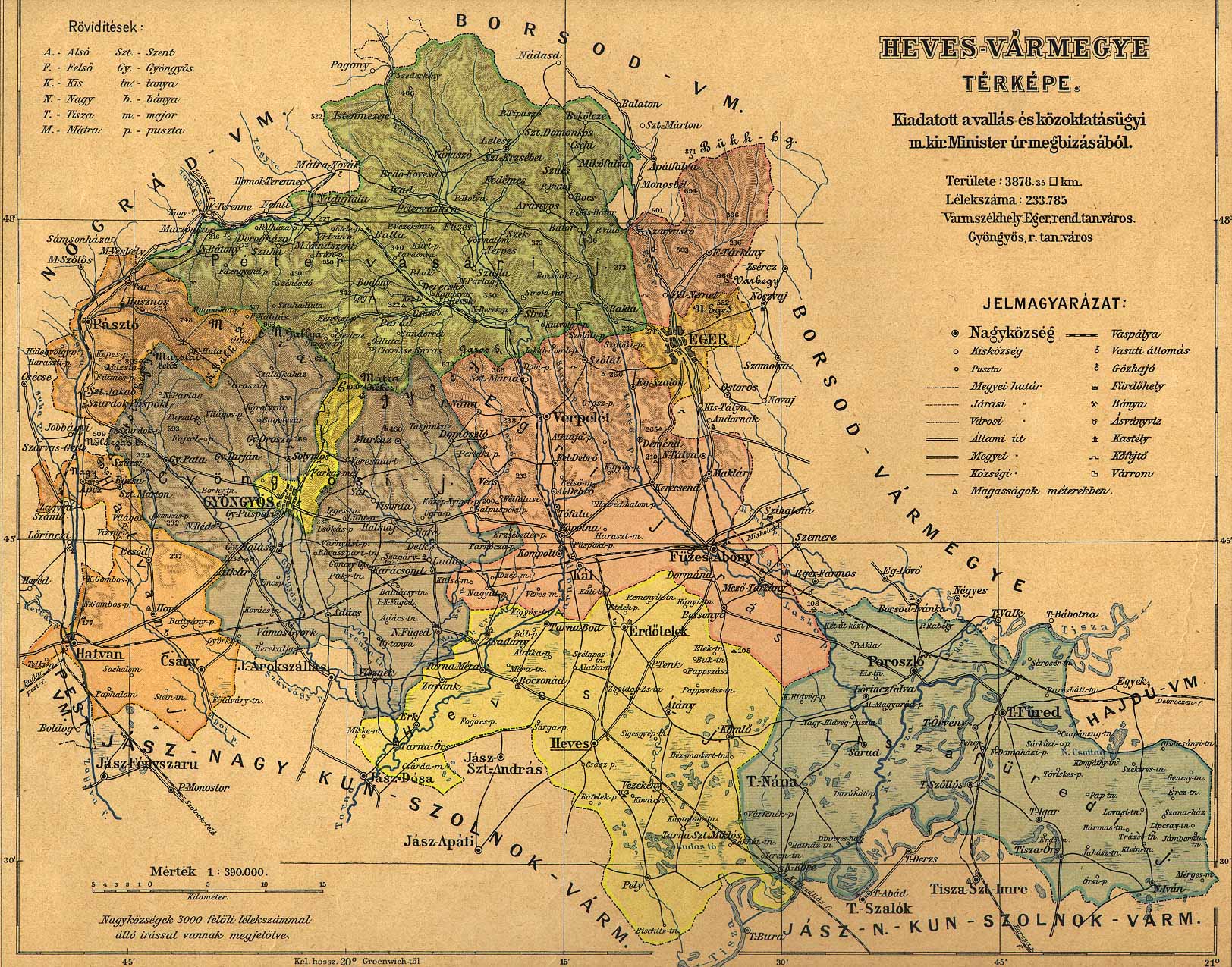Heves County (former) on:
[Wikipedia]
[Google]
[Amazon]
Heves was an administrative county in the

 In the early 20th century, the subdivisions of Heves county were:
In the early 20th century, the subdivisions of Heves county were:
Kingdom of Hungary
The Kingdom of Hungary was a monarchy in Central Europe that existed for nearly a millennium, from the Middle Ages into the 20th century. The Principality of Hungary emerged as a Christian kingdom upon the coronation of the first king Stephen ...
. Its territory, which is now in northern Hungary
Hungary ( hu, Magyarország ) is a landlocked country in Central Europe. Spanning of the Carpathian Basin, it is bordered by Slovakia to the north, Ukraine to the northeast, Romania to the east and southeast, Serbia to the south, Croatia a ...
, was slightly larger than that of present Heves county
Heves county ( hu, Heves megye, ) lies in northern Hungary, between the right bank of the river Tisza and the Mátra and Bükk mountains. It shares borders with the Hungarian counties Pest, Nógrád, Borsod-Abaúj-Zemplén and Jász-Nagykun-S ...
. The capital of the county was Eger
Eger ( , ; ; also known by other alternative names) is the county seat of Heves County, and the second largest city in Northern Hungary (after Miskolc). A city with county rights. Eger is best known for its castle, thermal baths, baroque build ...
.
Geography
Heves county shared borders with the Hungarian countiesPest-Pilis-Solt-Kiskun
Pest-Pilis-Solt-Kiskun is the name of an administrative county (comitatus) of the Kingdom of Hungary. Its territory is now in central Hungary, comprising the territory of the present Hungarian county Pest and the northern part of present Bács-K ...
, Nógrád
Nógrád ( sk, Novohrad; german: Neuburg) is a village in Nógrád County, Hungary
Hungary ( hu, Magyarország ) is a landlocked country in Central Europe. Spanning of the Carpathian Basin, it is bordered by Slovakia to the north, ...
, Gömör-Kishont, Borsod, Hajdú and Jász-Nagykun-Szolnok. It stretched from the Mátra
The Mátra ( sk, Matra) is a mountain range in northern Hungary, between the towns Gyöngyös and Eger. The country's highest peak, Kékestető (1014 m), belongs to this mountain range.
The Mátra is part of the North Hungarian Mountains ...
and Bükk
The Bükk Mountains () are a section of the North Hungarian Mountains of the Inner Western Carpathians. Much of the area is included in the Bükk National Park.
Geography
Although Kékes, the highest point in Hungary, is not here but in the n ...
mountains to and across the river Tisza
The Tisza, Tysa or Tisa, is one of the major rivers of Central and Eastern Europe. Once, it was called "the most Hungarian river" because it flowed entirely within the Kingdom of Hungary. Today, it crosses several national borders.
The Tisza be ...
. Its area was around 1910.
History
Heves county was formed in the 13th century. The territory of Heves was conquered by theOttomans
The Ottoman Turks ( tr, Osmanlı Türkleri), were the Turkic founding and sociopolitically the most dominant ethnic group of the Ottoman Empire ( 1299/1302–1922).
Reliable information about the early history of Ottoman Turks remains scarce, ...
in 1596 (see Ottoman Hungary
Ottoman Hungary ( hu, Török hódoltság) was the southern and central parts of what had been the Kingdom of Hungary in the late medieval period, which were conquered and ruled by the Ottoman Empire from 1541 to 1699. The Ottoman rule covered ...
) and formed part of the Ottoman Eğri Eyalet
Eğri Eyalet ( ota, ایالت اگیر; Eyālet-i Egīr, hu, Egri vilajet, sr, Jegarski ejalet or Јегарски ејалет) or Pashaluk of Eğri was an administrative territorial entity of the Ottoman Empire formed in 1596 with its capita ...
until it was retaken by the Habsburg Kingdom of Hungary in 1687.
In 1765 it was ; due to the occupation the latter could not maintain its administration (the justice system had already been merged in 1569).
Following the failed Hungarian Revolution of 1848
The Hungarian Revolution of 1848 or fully Hungarian Civic Revolution and War of Independence of 1848–1849 () was one of many European Revolutions of 1848 and was closely linked to other revolutions of 1848 in the Habsburg areas. Although th ...
a period of military dictatorship and centralisation began in Hungary. Heves-Külső-Szolnok was re-partitioned on 13 September 1850 into Heves and Szolnok counties. The border between Heves and Szolnok mostly followed the Tisza
The Tisza, Tysa or Tisa, is one of the major rivers of Central and Eastern Europe. Once, it was called "the most Hungarian river" because it flowed entirely within the Kingdom of Hungary. Today, it crosses several national borders.
The Tisza be ...
river. As of 1853 Heves comprised the and of Erlau
Erlau is a municipality in the district of Mittelsachsen in Saxony in Germany
Germany,, officially the Federal Republic of Germany, is a country in Central Europe. It is the second most populous country in Europe after Russia, and ...
(Eger) and the of Pétervásár, Heves
Heves is a small town in eastern Hungary. About 100 km east of Budapest, Heves lies at the northern extreme of the Great Hungarian Plain, just south of the Mátra and Bükk hills and west of the Tisza River. Heves gave its name to the Heves ...
, and Gyöngyös
Gyöngyös (; german: Gengeß) is a town in Heves county in Hungary, east of Budapest. Situated at the foot of the Sár-hegy and Mátra mountains, it is the home of numerous food production plants, including milk production and sausage factori ...
. Both counties formed part of the District of Pest-Ofen during this period. The traditional counties of Hungry, including Heves-Külső-Szolnok, were restored in October 1860.
Heves County was recreated again in the newly arranged Hungarian county system of 1876. Its territory after 1876 was broadly similar to its 1850s iteration but with the addition of Tisza-Füred south of the Tisza.
After World War II
World War II or the Second World War, often abbreviated as WWII or WW2, was a world war that lasted from 1939 to 1945. It involved the vast majority of the world's countries—including all of the great powers—forming two opposin ...
, the territory of the county was modified: the region around Pásztó
Pásztó is a town in Nógrád County, Hungary.
Tibor Rubin was born in Pásztó on 18 June 1929. It then had a Jewish population of 120 families.
Twin towns – sister cities
Pásztó is twinned with:
* Ruffec, France
Notable people
* Anta ...
became part of Nógrád
Nógrád ( sk, Novohrad; german: Neuburg) is a village in Nógrád County, Hungary
Hungary ( hu, Magyarország ) is a landlocked country in Central Europe. Spanning of the Carpathian Basin, it is bordered by Slovakia to the north, ...
county, the area on the left bank of the Tisza (Tiszafüred) became part of Jász-Nagykun-Szolnok county, and an area north of Eger was transferred from Borsod-Abaúj-Zemplén county.
Demographics

Subdivisions
 In the early 20th century, the subdivisions of Heves county were:
In the early 20th century, the subdivisions of Heves county were:
Notes
References
{{DEFAULTSORT:Heves County (Former) States and territories established in 1687 States and territories established in 1876 1596 disestablishments 1765 disestablishments in Europe States and territories disestablished in 1946 Counties in the Kingdom of Hungary